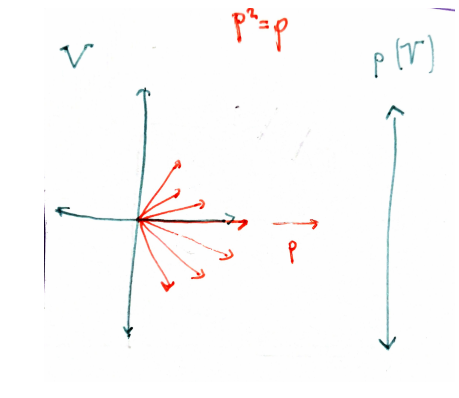Jordan canonical form
This is a basic fact of Linear Algebra.
In general, we have that for an endomorphism $f:V\mapsto V$
$$ Im(f)\cong V/Ker(f) $$and so $dim (V)=dim(Ker(f))+dim (Im(f))$.
But we don't always have that $V=Ker(f)\oplus Im(f)$. Now, if $f\circ f=f$, i.e., $f$ is idempotent, the previous formula holds: for every $v\in V$ we have that $v=v-f(v)+f(v)=(v-f(v),f(v))$ and conversely, for $(h,w)\in Ker(f)\oplus Im(f)$ we can take $h+w \in V$ such that $(h+w-f(h+w),f(h+w))=(h,w)$

This is the same as being a projection.
More generally, we have
Proposition
If $f$ is such that $Im(f)=Im(f^2)$, we have
$$ V=Ker(f)\oplus Im(f) $$Proof
First, let's observe that $f|_{Im(f)}$ is an isomorphismm. This is so because it is surjective and dimensions are equals.
We can construct an isomorphism $V\rightarrow Ker(f)\times Im(f)$ at the following way:
$$ v\mapsto (v-f(x),f(x)) $$where $x$ is such that $f^2(x)=f(v)$ ($x$ exists because $Im(f)=Im(f^2)$).
It is easy to prove injectivity and surjectivity. Only rest to show that is well defined. Let us suppose that, for $v\in V$ we get $x\neq y$ such that $f^2(x)=f^2(y)=f(v)$. Then, since the restriction of $f$ is an isomorphism, $f(x)=f(y)$.
$\blacksquare$
At the same way, we can prove the following proposition
Propostion
For any endomorphism $f: V\rightarrow V$ there exists $m\geq 1$ such that
$$ Ker(f^m)\oplus Im(f^m) $$Proof
Observe that $Im(f)\supseteq Im(f^2)\supseteq Im(f^3) \supseteq \cdots$
And therefore, there exist $m$ such that $Im(f^m)=Im(f^{m+1})=\cdots=Im(f^{2m})=\cdots$.
At this point, we only have to apply the previous proposition to the transformation $h=f^m$.
$\blacksquare$
Now, we are ready to show the Jordan canonical form. Let $V$ be a complex vector space, and $f\in end(V)$. If $f$ is decomposable, we take a decomposition $V=\bigoplus_i U_i$, with $f(U_i) \subseteq U_i$ (invariant subspace) and proceed with every $f_i=f|_{U_i}$. So assume $f$ is indecomposable.
Consider $\lambda \in \mathbb{C}$ such that $f(v)=\lambda v$. It exists, because we can choose a
basis and contruct the polynomic equation $det(A-\lambda I)=0$, and $\mathbb{C}$ is algebraically closed. So, for certain $\lambda$, $Ker(f-\lambda id)$ as, at least, dimension 1. Moreover, observe that $\lambda$ is the only (possibly multiple) solution to the previous polynomial equation
We define $h=f-\lambda id$, and apply the previous proposition, so we get
$$V=ker(h^m) \oplus im(h^m)$$
for $m \geq 1$.
Since $f$ is indecomposable and $v\in ker(h^m)$ (since $f(v)-\lambda v=0$) we have that $V=ker(h^m)$, and therefore $h^m:V\mapsto V$ is the null transformation and $h$ is \emph{nilpotent}. Let $k$ be the nilpotency index, and $w \in V$ such that $h^{k-1}(w)\neq 0$ but $h^{k}(w)= 0$.
We can show that $\{w, h(w), h^2(w), \ldots , h^k(w)\}$ is a basis for $V$. First, observe that they are independent because if
$$ \sum_i a_i h^i(w)=0 $$we can apply $h$ several times to show that every $a_i=0$.
And second, we can show that they span $V$. In fact, let $E=span\{w, h(w), h^2(w), \ldots , h^k(w)\}$. Observe that:
- $f(w)\in E$, since $h(w)=f(w)-\lambda w$.
- $f^2(w) \in E$, since $h^2(w)=f^2(w)-2\lambda f(w)+\lambda^2 w$. Therefore, $f(h(w)) \in E$, because $f(h(w))=f^2(w)-\lambda f(w)$ and so $h^2(w)=f(h(w))-\lambda h(w)$.
- $f^3(w) \in E$ and therefore $f(h^2(w)) \in E$. In fact, $f(h^2(w))=h(f(h(w)))=h(h^2(w)+\lambda h(w))=h^3(w)+\lambda h^2(w)$
- In general, $f(h^i(w))=h(f(h^{i-1}(w)))=h(h^{i}+\lambda h^{i-1}))=h^{i+1}(w)+\lambda h^i(w)$.
Since $f(E)\subseteq E$ and $f$ is, by hypothesis, indecomposable, we conclude that $V=E$.
It only rests to show the form of the matrix of $f$ respect to the basis $\{w, h(w), h^2(w), \ldots , h^k(w)\}$. But because of the facts of the above enumeration we conclude that
$$ f\equiv \left( \begin{array}{cccc} \lambda & 0 & 0 &\ldots\\ 1 & \lambda & 0 & \ldots\\ 0 & 1 & \lambda &\ldots\\ \ldots & \ldots &\ldots &\ldots \end{array} \right) $$In conclusion: For any endomorphism $f$ of $V$ we can find a partition $U_i$ of $f$-stables vector subspaces of $V$.
In each of one, $f_i$ has the form of the matrix above (in a particular basis). This is so because, either $f_i$ is a escalar matrix ($f_i=\lambda Id$) or $f_i-\lambda Id$ is nilpotent, and for nilpotent operators we have the special basis $\{h^k(w), h^{k-1}(w), \ldots, w\}$.
By the way: it there exists other decomposition in $f$-stables subspaces, but not satisfying that matrix form.
________________________________________
________________________________________
________________________________________
Author of the notes: Antonio J. Pan-Collantes
INDEX: